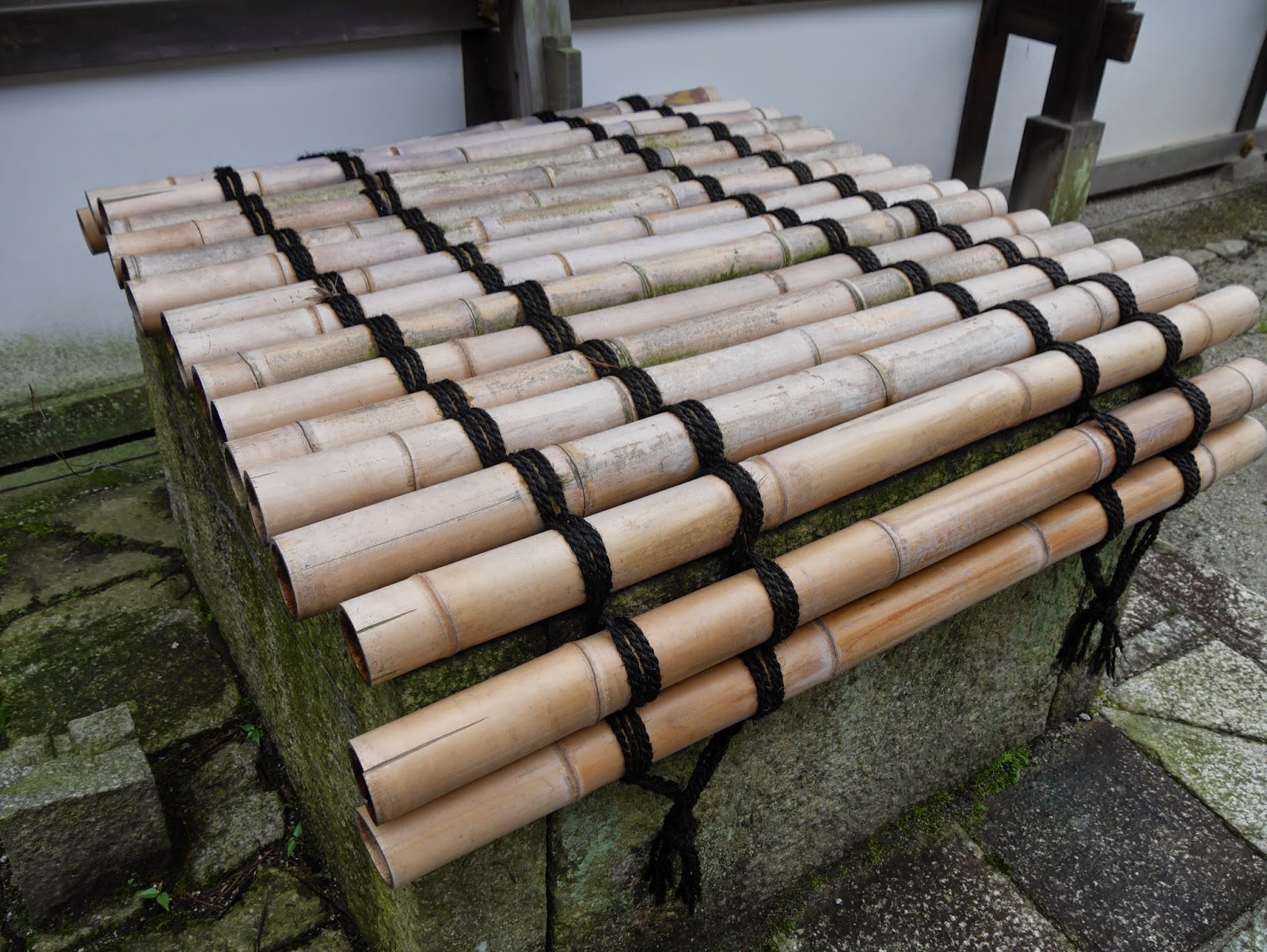Behind Shishin-den is the hall where the Emperors in Hei'an Period normally lived in. It is called as Seiryo-den. The interior is divided into rooms by folding screens. Its front side (east side) has a thick tatami, called Hino'omashi, which served as imperial throne. Bamboos are planted in front of Seiryo-den, which named as Kuretake (north side) and Kawatake (south side).
 |
| Kawatake |
 |
| South side of Seiryo-den. The floor in front of folding screens is paved by lime. It is named as Ishibai-no-dan and served as the place where Emperor prays to the direction of Ise Grand Shrine. |
 |
| Hino'omashi |
 |
| Kuretake |
 |
| Takiguchi, the place where ancient samurai stood by for security. |
After visited Seiryo-den, the route turned east and headed to Kogosho. Giyo-den was passed by before reached Kogosho.
 |
| Roof of Kogosho (south side) |
 |
| South side of Kogosho, Nikka-mon of Shishin-den could be seen from here. |
 |
| Banzai-ban |
Banzai-ban (ban means banner) was stood at inner side of Daikin-ban during enthronement ceremony. (Daikin-ban were stood at east and west side) The banner is decorated with images of fish and clay pot at its top part. while a golden "Banzai" was sewn at bottom part.
Clay pot is a wine pottery used in religious ceremony. According to the legend, Emperor Shinmu sank a clay pot into a river to pray for his victory during his expedition to the East. When the clay pot disappeared from the surface, a lot of fishes came to the surface and opened their mouth wide. It was believed to be an auspicious sign.
 |
| Daikin-ban, Yatagarasu (the black crow) on red banner and Reishi (Kite) on golden banner. |
 |
Nissho-ban (Sun Banner, the red banner with golden circle) and Gessho-ban (Moon Banner, the white banner with silver circle).
Both banners were used during Emperor Showa's enthronement ceremony and stood in front of Sakon-no-sakura and Ukon-no-tachibana respectively. |
 |
| Okangai, a special umbrella used in Daijyosai, the Great Harvest Ritual of the enthronement ceremony. |
 |
| Beside Giyo-den, the gate with red pillars is Nikka-mon. |
 |
Kogosho.
Manzairaku, the traditional court music and dance, was exhibited. |
Kogosho was a place where rituals held. It also served as a place where the Emperor had a meeting with buke (the bannermen under the direct control of Tokugawa shogun). This buiding is a blend of architectural elements of shinden-tsukuri style and shoin-tsukuri style.
In 1868, the first Kogosho meeting was held here. This is the first meeting when the Restoration of Imperial Rule (Osei Fukko) was declared, which marks the end of Edo Shogunate. Kogosho was burned down in 1954 and rebuilt in 1958.
Manzairaku is the traditional court music and dance performed in the Great Banquet of the enthronement ceremony of Emperor Taisho. It is part of Gagaku music, which inherited from Tang Dynasty of China. Manzairaku normally performed in Hiramai style, which performed by 4 to 6 dancers. Dancers wear a robe without covering their right shoulder and Torikabuto hat. The dance praises about the rule of a good king and the presence of Ho-o (phoenix).
 |
| Kemari-no-niwa. Kemari is a game of passing ball made of deer skin without drop to the floor. |
Kemari-no-niwa is located beside Kogosho, while the building beside Kemari-no-niwa is Ogakumonjyo. Ogakumonjyo was mainly used for intellectual activities such as reading rites and poetry recital. It was served as a place where the Emperor received nobles. Ogakumonjyo is a building of Shoin-tsukuri style. Its interior is divided into three rooms, which named as Jyodan-no-ma (Upper Room), Chudan-no-ma (Middle Room) and Gedan-no-ma (Lower Room). The drawings on folding screens in these rooms are related to the poetry of China.
 |
| Ogakumonjyo |
 |
Lower Room of Ogakumonjyo.
"Yueyang Pavilion" (Hara Zaisho's work) |
 |
Middle Room of Ogakumonjyo.
"Gathering at the Orchid Pavilion" (Gan Tai's work) |
 |
Upper Room of Ogakumonjyo.
"Eighteen Scholars Ascending Yingzhou, the Mountain of Immortals" (Kano Eigaku's work) |
Opposite of Kogosho and Ogakumonjyo is Oikeniwa, which is a Kaiyu-style garden centered on a pond.
 |
| Oikeniwa |
 |
| Hayaki-no-bashi at the south side of Oikeniwa |
 |
| Ducks in Oikeniwa |
Otsunegoden is located just a few steps ahead. It was used as the Emperor's residence from Muramachi Period (16th century) till 1869 when the capital was transferred to Tokyo. It is the largest building in Gosho with fifteen rooms. Followings are the folding screens at east side of Otsunegoden.
 |
| Gonaitei, located at east side of Otsunegoden. |
 |
| Osuzumisho, which is the summer residence for the Emperor. The courtyard in front of it is called as Koshun. Koshun is a study hall that was used by Emperor Komei (1846 - 1866). The building north from here is close to public. |
 |
| South side of Otsunegoden |
 |
| Drawings on folding screens at the south side of Otsunegoden are related to the ancient Emperors of China |
 |
| "Emperor Gaozong's Dream of Receiving a Virtuous Retainer" (partial, Lower Room, Left side), Emperor Gaozong reigned during Shang Dynasty. |
 |
| "Emperor Yu Warning Against Drinking and Preventing Calamities" (Middle Room) |
 |
| "Emperor Yao Appointing a Sage to Rule the Country" (partial, Upper Room, right side) |
 |
| Well beside Otsunegoden |
Beside Otsunegoden is Omima, which was used for unofficial ceremonies such as the Star Festival and the Bon Festival. The drawings on folding screens are all about the stories of ancient Emperors of Japan.
 |
| "Imperial Procession to Kamo Shrine" in Middle Room of Omima |
After passing through a square, we left from Seisho-mon and ended our trip at Kyoto Gosho.
Next:
Sagano Torokko Train, a Trip to Hozukyo Valley






































No comments:
Post a Comment